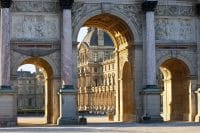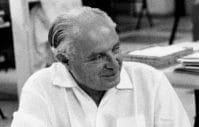
Rococo Style: How it Distincts in Architecture, Furnishings and Painting
Rococo Style: Birth and Development The Rococo, as a reflection of the trends, tastes and way of life of France…
Last quarter of the 17th century
cm. 120 x 150 (145 x 177 including frame)
NORDIC ARTIST ACTIVE IN ROME IN THE LAST QUARTER OF THE 17TH CENTURY
Still life with vase of flowers, fruits and architectural ruins
The painting is part of a pair: the twin is also visible in the gallery, but they can be purchased individually.
Oil on canvas – cm. 120 x 150 (145 x 177 including frame)
The two large canvases presented here, depicting Still Life with Flowers, Fruits, Historiated Vases, a Parrot and a Monkey and Still Life with Vase of Flowers, Fruits and Architectural Ruins, are typical examples of the great Baroque decoration which saw its maximum splendor in Rome in the second half of the 17th century. The magnificent Baroque splendor took its most striking forms in the great aristocratic palaces of the Colonna, the Chigi, the Borghese, the Rospigliosi, the Pallavicini, where the greatest exponents of figure and landscape painting and genres active in that era worked in Rome. This taste gradually took hold also among the minor patricians and the upper bourgeoisie of bankers and professionals, who made use of lesser-known artists from the workshops that were flourishing in the city. As regards still life depictions, the greatest representatives were initially specialists: Mario Nuzzi and Giovanni Stanchi for the flowers, Michelangelo del Campidoglio for the fruits, Francesco Noletti for the elegant compositions with carpets. In the second half of the century, artists moved in the direction of greater versatility, so for example a painter of Apulian origin like Carlo Manieri painted all three of the above-mentioned subjects indifferently, often mixing them within the same compositions. A fundamental contribution to the development of the so-called Roman genre painting was that given by the numerous group of foreign artists active in the city: it included Flemish, Dutch and German artists, gathered in guilds called Bent. The French colony was also flourishing, but these were painters of the highest artistic lineage, figure specialists dedicated to historical, mythological and religious scenes, sent to Italy under the protection of Louis XIV, who could count on attendance at the prestigious Academy of France, founded in 1666 on the initiative of Jean-Baptiste Colbert and Gian Lorenzo Bernini. The two large canvases presented here are works by a Nordic painter fascinated by Roman culture, so clearly evident in the vanishing perspective display of two historiated vases in the painting with monkey and parrot, conceived to be positioned on the left, and of two plinths in the other, conceived to be the right element of the couple. The Nordic term is intended to refer generically to an artist of Flemish culture who could, however, also have derived his origins in Germany, as demonstrated by the formidable Roman examples of Christian Berentz and Franz Werner von Tamm. However, the mix of fruits, flowers, small animals such as monkeys and parrots, decorated vases and classical artefacts displayed outdoors with narrow landscape openings makes one think more of a painter who was well acquainted with the works of David de Coninck from Antwerp, who remained in Rome from 1672 to 1694.

Rococo Style: Birth and Development The Rococo, as a reflection of the trends, tastes and way of life of France…

The Empire style, with its magnificent fusion of majesty and grace, remains an icon of classic furnishings, exerting a timeless charm…

Giò Ponti is one of the artists who most dominated the Italian post-war period, acting as a spokesperson for important innovations in the world…
have viewed this article in the last 30 minutes.